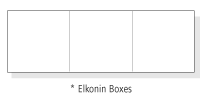Segmenting and Blending Words
Main Core Tie
English Language Arts Kindergarten
Reading: Foundational Skills Standard 2 d.
Time Frame
5 class periods of 15 minutes each
Group Size
Small Groups
Summary
This activity introduces the concept of segmentation and blending words.
Materials
- Name cards with children's names.
- Word cards with simple three letter short vowel words.
- Elkonin Boxes and game markers to move into boxes.
Background for Teachers
Segmentation is being able to hear a word and then say the individual sounds in the word. (man-m-a-n)
Blending is taking the sounds and blending them together to make a word. (mmm-aaaa-nnnn -- man)
Student Prior Knowledge
Students should be able to identify beginning, middle and ending sounds.
Intended Learning Outcomes
Students will be able to hear a word and segment it. They will be able to hear or say the sounds and blend it into a word.
Instructional Procedures
These activities should be done in a small group if possible.
Introduction:
- Write the names of the students in the group on cards and place them on a board or easel in front of the children.
- Take one name and ask, "How many letters are in this name?"
- And then ask, "How many sounds are in this name?"
- Model how to break the name into phonemes or indvidual sounds.
Tom - /t/ /o/ /m/
Mary /m/ /air/ /e/
Try not to use r-controlled vowels if possible.
- Place several words on the board and tell the students you are going to read the word and have them say the indvidual sounds. (bat b-a-t)
- Do this with several words and then explain to the students that you are going to do it another way. You are going to say the sounds and the students will give you the word.
Say, "bbb-aaa-ttt"
The students should then say "bat".
- Play a guessing game.
Tell the students that you are going to say the sounds in a word, and they are going to see who can say the word first. If one or two children continually say the word, then specifically name a child to do a word or go around the table.
- Do the opposite.
Say the word and have the children say the sounds or segment the word.
- Many schools in Utah use DIBELS - testing which has phoneme segmentation. It would be beneficial to tell the children that when they do this it is phoneme segmentation.
- Pass out Elkonin boxes (three or four connected boxes on a paper.)

Pass out the game markers and have the students move a marker into the first box as they make the first sound. Next, they should move the second game marker into the second box as they make the second sound, etc.
("Fish" would have f-i-sh or three sounds.)
- Point out to the students that even though there are four letters, the word "fish" has three sounds.
- Give each student a paper with several words and the word that goes with the picture. Have the child color in the number of squares for each sound they say when they read the picture.
Extensions
Attachments
Assessment Plan
The teacher will observe the students' responses in small group instruction.
The final activity provides the teacher with a sample of the children demonstrating their knowledge of segmentation.
Updated: 02/05/2018


 UTAH EDUCATION NETWORK
UTAH EDUCATION NETWORK

 Justin
Justin Braxton
Braxton Dani
Dani Kayla
Kayla Katie
Katie Matthew
Matthew Rob
Rob Val
Val
